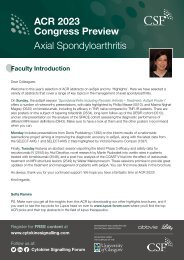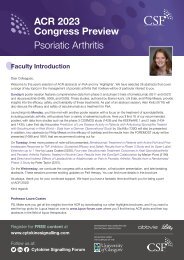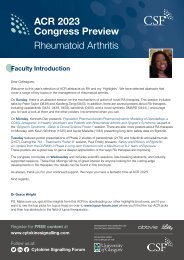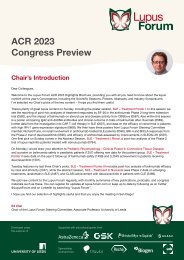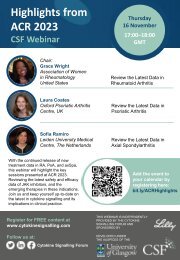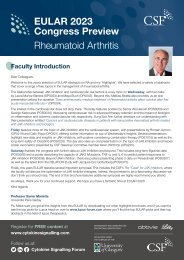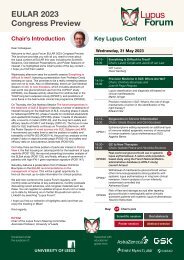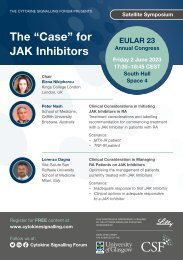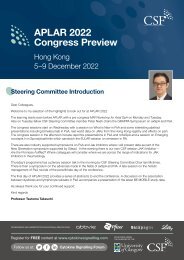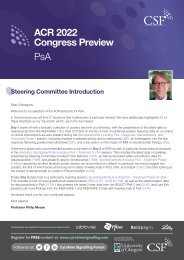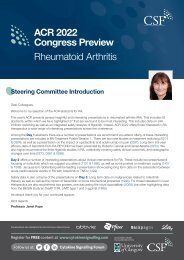ACR Congress Review 2019
Create successful ePaper yourself
Turn your PDF publications into a flip-book with our unique Google optimized e-Paper software.
In the first presentation, the analyses included a total of 1544 tofacitinib (2138.2 patient years) and 7083<br />
bDMARD (9904.9 patient years) initiators. Rates of MACE and serious infection events were similar in<br />
patients starting tofacitinib or bDMARDs for RA. The herpes zoster incidence rate was higher for<br />
tofacitinib versus bDMARDs and hazard ratios (HR) for herpes zoster were significantly increased with<br />
tofacitinib versus bDMARDs (adjusted HR 2.12, 95% CI: 1.22, 3.66). All herpes zoster events were nonserious<br />
with tofacitinib. VTE IRs were similar in both cohorts [2372].<br />
In a second presentation, the authors compared 5-year IRs of malignancy and mortality in a total of 1999<br />
tofacitinib (4505.62 PY) and 6354 bDMARD (16670.84 PY) initiators. RA patients initiating tofacitinib or<br />
bDMARDs had similar rates of total cancer excluding NMSC, NMSC, and death, with adjusted HRs<br />
(95% CI) of 1.04 (0.68, 1.61), 1.02 (0.69, 1.50), and 1.0 (0.62, 1.63), respectively [2874*].<br />
Risk of serious infections with tofacitinib<br />
A poster presenting the comparative incidence rates of serious bacterial, viral or opportunistic infections<br />
in RA patients was presented by Pawar and colleagues. Using data from three US healthcare claims<br />
databases, a total of 123,960 biologic initiators were identified, of which 4.5% were tofacitinib initiators. A<br />
total of 2,958 serious infection events occurred. In the tofacitinib group, the crude IR for serious<br />
infections per 100 person-years ranged from 2.80 (MarketScan) to 7.89 (Medicare). Adjusted HRs<br />
showed higher risk of composite serious infections with tofacitinib compared with abatacept (HR 1.20,<br />
95% CI 1.09-1.31), etanercept (1.27, 1.14-1.42), golimumab (1.35, 1.29-1.40) and tocilizumab (1.46,<br />
1.31-1.63), but similar risk compared to adalimumab, certolizumab and infliximab. Serious bacterial<br />
infection risk was higher in tofacitinib than abatacept (1.15, 1.09-1.21), certolizumab (1.16, 1.10-1.23),<br />
etanercept 1.14 (1.04-1.25) and golimumab (1.21, 1.06-1.39) [2826].<br />
Vinet and colleagues presented results from a study comparing the risk of serious infections in children<br />
born to mothers with chronic inflammatory diseases who used non-TNFi biologics or tofacitinib during<br />
pregnancy, versus unexposed offspring and children exposed to TNFi in utero. The US MarketScan<br />
database was used to identify 16,490 offspring of mothers with RA (4,142), AS (381), PsO/PsA (5,743),<br />
and inflammatory bowel disease (6,731), as well as 164,553 children born to unaffected mothers<br />
matched for age, year of delivery and state of residence. Very few serious infections were detected in<br />
children exposed to non-TNFi biologics or tofacitinib (2 cases [1.9%]: one case was exposed to<br />
tofacitinib, while the other was exposed to abatacept). The percent of serious infections in offspring of<br />
inflammatory disease mothers with no TNFi exposure was 2.1%, while for those with TNFi in utero<br />
exposure, it was 2.3%. In children born to unaffected mothers, the percent of serious infections was<br />
1.6% [1901].<br />
Baricitinib<br />
Post-marketing surveillance of baricitinib safety in RA<br />
A poster presenting baricitinib safety based on post-marketing surveillance data was presented by<br />
Matsuno and colleagues. This interim report summarized registration data including pre-treatment test<br />
rates and AEs. As of August 2018, 1288 patients had been enrolled. Registration data were reported as<br />
follows: women, 81%; mean age, 64 years old; mean RA duration, 12 years; Steinbrocker stage II, 32%;<br />
stage III or IV, 52%; baricitinib 4 mg, 68%; baricitinib 2 mg 32%; MTX use, 57%; corticosteroid use, 51%;<br />
pre-treatment test for tuberculosis, 93%; HBV, 95%; HCV, 93%; and eGFR, 96%. Of 299 AEs collected,<br />
53 were SAEs. SAEs reported in 2 or more patients were pneumonia (n=8), fall (n=4), osteonecrosis<br />
(n=3), herpes zoster (n=2) and interstitial lung disease (n=2). Pulmonary TB (n=1), lymph node TB (n=1)<br />
and DVT (n=1) were also reported as SAEs. Overall, safety findings were consistent with baricitinib’s<br />
known safety profile. These data highlight that care is needed to ensure that all pre-treatment tests are<br />
conducted in all patients [2375].<br />
*Chairman’s Pick



